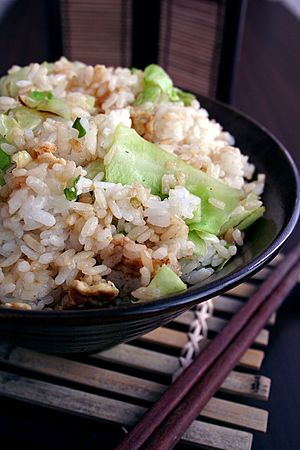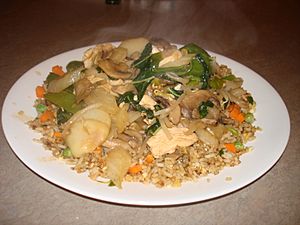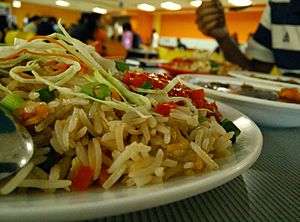Chinese fried rice facts for kids
 |
|
| Type | Fried rice |
|---|---|
| Place of origin | China |
| Region or state | Greater China |
| Main ingredients | Cooked rice |
| Variations | Hokkien fried rice, Yangzhou fried rice, yin yang fried rice |
Chinese fried rice (simplified Chinese: 炒饭; traditional Chinese: 炒飯; pinyin: chǎofàn) is a super popular dish made from fried rice. You can find it all over Greater China and in many other countries too! Sometimes, it's served as one of the last dishes at big Chinese parties, right before dessert.
Contents
The Story of Fried Rice
Fried rice has a long history! The first time we hear about it is way back in the Sui dynasty (589–618 CE). That's over 1,400 years ago!
The cooking style used for fried rice, called stir-frying, became really popular later on, during the late Ming dynasty (1368–1644 CE).
People think fried rice started as a clever way to use up leftovers. In Southern China, people usually eat plain, white rice with their meals. So, if there were leftover rice, meat, and vegetables from the day before, they didn't want to waste them. They would mix these leftovers with soy sauce, lard (a type of fat), and garlic. Then, they would quickly cook it all in a hot pan. This made a yummy, hot meal out of food that might otherwise have been thrown away!
The main things you need for Chinese fried rice are rice, some kind of meat, vegetables, soy sauce, and garlic. Over time, many different kinds of fried rice recipes were created in China, like Yangzhou and Sichuan fried rice. The basic idea of stir-frying rice in a Chinese wok (a special round pan) spread from Southern China to other places in East Asia and Southeast Asia.
What's in It and How It's Made
The main parts of Chinese fried rice are cooked rice, meat, and vegetables. These are mixed with egg, soy sauce, and garlic to give it flavor. You also need cooking oil, like lard, vegetable oil, or sesame oil. The oil and soy sauce help coat the rice grains. This stops them from burning or sticking to the pan while cooking.
Sometimes, people add other tasty things like chopped scallions, ginger, chili peppers, mushrooms, or diced pork. All these ingredients are cooked quickly over a strong fire in a Chinese wok. The cook uses a spatula to turn, stir, and move the rice around. This makes sure everything cooks evenly and the flavors spread out. It's common to use leftover rice for this dish, and you can add other leftover ingredients too!
Different Kinds of Fried Rice
The basic Chinese fried rice is made by stir-frying cooked rice with chopped vegetables and meat, then seasoning it with soy sauce and garlic. Since it started as a simple way to use leftovers, there isn't just one exact recipe. Every family might have its own special way to make fried rice, leading to tons of different kinds! The types can change based on what's inside, the seasonings, spices, and the vegetables and meat used. This flexibility and its ability to save food made stir-fried rice super popular in China.
Today, there are many famous Chinese fried rice recipes. Some are named after regions, like Yangzhou fried rice (扬州炒饭) from Yangzhou. There's also Hokkien fried rice (Chinese: 福建炒飯) from Fujian, and spicy Sichuan fried rice from Sichuan. Sichuan fried rice is known for its tangy, hot, and spicy taste, thanks to a chili sauce called doubanjiang mixed with garlic and onions.
Chinese fried rice dishes also traveled to other parts of the world. The stir-frying method using a Chinese wok, and using soy sauce for flavor, clearly show how much Chinese cooking influenced other places. These cooking ideas spread to nearby East Asian countries, Southeast Asia, and then to the rest of the world. For example, Japanese chāhan (チャーハン) came from fried rice made by Chinese people who moved to Japan in the 1800s. Even though Indonesian nasi goreng has a stronger flavor, it's also thought to have been influenced by Chinese fried rice.
Countries in Latin America also have their own versions of Chinese fried rice. These include arroz chaufa (Peruvian-Chinese fried rice) and arroz frito (Cuban-Chinese fried rice). Indian pulao also shows some influence from Chinese fried rice.
Fried Rice Around the World

Chinese fried rice is a very common dish in American Chinese cuisine, especially in fast food restaurants. The most common kind of American Chinese fried rice usually has eggs, scallions, and other vegetables. You can often add chopped meat if you want. It's usually flavored with soy sauce instead of just table salt, which is more typical for Chinese-style fried rice. Sometimes, Chinese restaurants in the United States offer a combo meal with chop suey served on top of fried rice.
One of the most popular types of fried rice in America is in Peru. There, it's called "Arroz Chaufa" and is one of the most famous dishes in Chifa restaurants (Peruvian-Chinese restaurants).
This dish is also a main item in Chinese restaurants in the United Kingdom, both for eating in and taking away. It's also super popular in the West African countries of Nigeria, Ghana, and Togo, where you can find it in restaurants and as street food.
In Korea, the Korean Chinese-style fried rice is a special kind of fried rice. It's different from other Korean-style fried rice dishes.
Even McDonald's has served a Chinese fried rice dish called McChao. "Chao" comes from chǎofàn, which means "fried rice" in Chinese!
Images for kids
-
Yangzhou fried rice (扬州炒饭) in the United States





